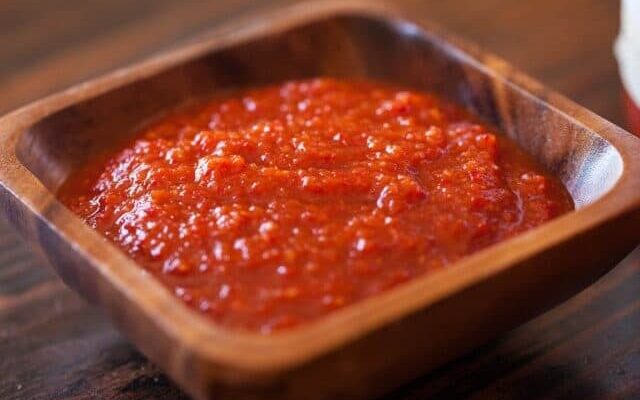Sriracha Sauce Recipe: Sriracha sauce is one of those condiments that can instantly upgrade a bland dish into a flavor-packed experience. Originating from the town of Si Racha in Thailand, this chili-garlic hot sauce has gained cult status globally. Known for its vibrant red color, slightly thick consistency, and a delicious balance of heat, sweetness, and tang, Sriracha is more than just a spicy sauce—it’s a flavor enhancer.
It typically combines chili peppers, garlic, vinegar, sugar, and salt. But here’s the best part—when you make it at home, you can adjust every component to your liking. Want it spicier? Add more peppers. Prefer a bit of sweetness? Increase the sugar. The DIY version also skips preservatives, making it a healthier choice.
From noodle bowls to burgers, soups to stir-fries, Sriracha is the secret ingredient that elevates dishes without overwhelming them. So, why not learn to make it from scratch? Trust me, once you’ve tried your homemade batch, the store-bought one will start gathering dust.
History and Origin
Believe it or not, Sriracha didn’t start as the global phenomenon it is today. It was originally crafted in the 1930s by a woman named Thanom Chakkapak in Si Racha, Thailand. Her version was a simple blend of red chili peppers, vinegar, garlic, sugar, and salt—ingredients readily available in local Thai kitchens.
The sauce quickly gained popularity in her town and then beyond. Fast forward a few decades, and Sriracha made its way to the U.S., thanks largely to David Tran, a Vietnamese immigrant who founded Huy Fong Foods in the 1980s. His rooster-branded bottle became synonymous with the sauce itself.
Today, Sriracha is used all over the world, not just in Asian cuisine. It’s a staple in kitchens, food trucks, and restaurants. But its commercial versions often contain preservatives and stabilizers. The homemade version, rooted in that original Thai recipe, brings it all back to the basics—fresh, bold, and real.
Why Make Homemade Sriracha?
Let’s be honest: grabbing a bottle off the shelf is easy. But making Sriracha from scratch? That’s an entirely different experience. Here’s why you should do it.
- Control Over Ingredients: Want organic peppers? Prefer less sugar or no added preservatives? Homemade gives you full control.
- Adjust Flavor Profile: Some like it hot, others like it milder. Adjust the spice, sweetness, and tang to match your taste perfectly.
- Fermentation Perks: When you ferment the chili-garlic mix, it develops deep umami-rich flavors that no store-bought bottle can offer.
- Satisfaction: There’s something incredibly satisfying about crafting your own condiments. You’ll not only impress your guests but also feel like a flavor magician in your own kitchen.
- Cost-Effective: A batch of homemade Sriracha costs a fraction of the store-bought versions, especially if you grow your own chili peppers.
Bottom line? Homemade Sriracha tastes better, is healthier, and adds a personal touch to your cooking adventures.
Ingredients You’ll Need
Core Ingredients
To create the bold, spicy magic of Sriracha, you only need a handful of ingredients—but each one plays a crucial role. Here’s what you’ll need:
- Red Chili Peppers (preferably Fresno or Thai red chilies): These bring the heat and color.
- Fresh Garlic: Adds depth and pungency.
- Distilled White Vinegar: Essential for tang and preservation.
- Granulated Sugar: Balances the heat with a touch of sweetness.
- Salt: Enhances all the other flavors.
Each of these ingredients is easily available at grocery stores, farmers’ markets, or online. The key is to use fresh, high-quality produce to make sure your sauce really shines.
Optional Add-ins for Flavor Twist
If you like experimenting in the kitchen, consider adding these optional ingredients:
- Shallots or Onions: For a sweeter, more complex base.
- Smoked Paprika: Adds a smoky edge to the sauce.
- Fish Sauce or Soy Sauce: For umami richness, especially if skipping fermentation.
- Lime Juice or Zest: A zingy brightness that lifts the overall flavor.
These ingredients are not traditional, but they can personalize your Sriracha to suit your taste preferences. Don’t be afraid to get creative!
Ingredient Sourcing Tips
Here’s how to find the best ingredients for your homemade sauce:
- Red Peppers: Farmer’s markets often have fresh, organic varieties that are perfect for Sriracha.
- Garlic: Avoid pre-minced or jarred garlic. Go for whole bulbs with firm cloves.
- Vinegar: White vinegar is the classic, but you can experiment with apple cider or rice vinegar for unique flavor profiles.
- Sugar: Granulated white sugar is standard, but brown sugar or honey can offer a richer sweetness.
Try to use organic and non-GMO ingredients wherever possible. The fresher the produce, the more vibrant your final sauce will be.
Kitchen Tools and Equipment
Essential Tools
To make Sriracha sauce at home, you won’t need a commercial kitchen. Just a few essential tools will do:
- Blender or Food Processor: For blending everything into a smooth paste.
- Fermentation Jar or Mason Jar: If you’re opting for the traditional fermented flavor.
- Rubber Spatula: Helps transfer your sauce without leaving any behind.
- Strainer: To get rid of any seeds or chunks, especially if you like a silky finish.
These tools are kitchen staples and will make the process smooth, clean, and efficient.
Nice-to-Have Gadgets
Though not essential, these gadgets can elevate your Sriracha-making game:
- Fermentation Weights: Helps keep ingredients submerged in brine.
- pH Meter: If you want to monitor acidity for safety and consistency.
- Glass Bottles with Drip Tips: For easy storage and convenient usage.
If you’re planning to make Sriracha often, investing in a few of these will make your process more streamlined and professional.
Sanitization and Storage Essentials
Cleanliness is key, especially when fermentation is involved:
- Sterilized Jars and Bottles: Prevent mold and bacterial growth.
- Boiling Water or Vinegar Wash: For sanitizing your tools before use.
- Labels and Markers: To date your batches and note ingredient variations.
Proper sanitization not only extends the shelf life but also ensures your sauce is safe to consume. Always wash your hands thoroughly and wear gloves when handling chili peppers.
Step-by-Step Guide to Making Sriracha Sauce
Step 1: Choosing the Right Peppers
Start with fresh red chili peppers—Thai chilies or red jalapeños deliver the perfect heat and color. Wash, stem, and roughly chop them. Add a few garlic cloves for an aromatic punch.
Step 2: Fermentation (The Flavor Booster)
Place the chopped peppers and garlic in a clean jar with a tablespoon of salt and enough water to cover. Loosely seal and ferment for 5–7 days, stirring daily. This step adds that iconic tangy depth.
Step 3: Blending and Cooking the Sauce
Blend the fermented mix with vinegar and a bit of sugar until smooth. Simmer for 10–15 minutes to thicken and meld flavors.
Step 4: Adjusting Taste and Texture
Taste and tweak—add more vinegar for tang, sugar for balance, or water for smoothness.
Step 5: Cooling, Bottling, and Storage
Cool completely, strain if desired, and pour into sterilized bottles. Store in the fridge for up to 3 months—your homemade fiery perfection is ready to elevate any dish!
Tips for the Perfect Sriracha Every Time
Common Mistakes to Avoid
Even the best home cooks slip up occasionally. Avoid these common mistakes when making Sriracha:
- Skipping sanitization: Dirty tools = spoiled sauce. Sterilize everything.
- Overcooking the sauce: This can burn the sugars and turn your sauce bitter.
- Not tasting during the process: Adjusting flavor is key—don’t rely on the recipe alone.
- Improper fermentation: Always use clean jars and monitor for mold. Bubbling is good—fuzzy mold is not.
- Ignoring pepper variety: Not all chilies are created equal. Know your heat levels.
Avoiding these mistakes will ensure your Sriracha is as good—or even better—than any bottle you’ve ever bought.
Flavor Pairing Suggestions
One of the coolest things about Sriracha is how versatile it is. Here are some food combos that work brilliantly with your homemade sauce:
- Eggs: From scrambled to deviled, Sriracha gives them a fiery twist.
- Noodles and Ramen: A spoonful adds depth to broths and sauces.
- Avocado Toast: A drizzle on top cuts through the creaminess.
- Grilled Meats: Brush it on chicken, pork, or beef for a killer glaze.
- Pizza and Burgers: A spicy kick to classic comfort foods.
You can also mix it with mayo, sour cream, or yogurt for an instant spicy dip or dressing. The flavor combos are endless.
Storage and Shelf Life Tips
To keep your homemade Sriracha tasting fresh:
- Always refrigerate once opened, even if fermented.
- Use clean utensils when scooping—no double dipping!
- If the sauce smells off or grows mold, discard it immediately.
Fermented sauces usually last up to 3 months, while non-fermented ones are best used within 2-4 weeks. Freezing is not recommended as it alters the texture, but small batches mean you’ll probably finish the bottle before that’s even an issue.
Creative Ways to Use Sriracha Sauce
Cooking Recipes Using Sriracha
Sriracha isn’t just for drizzling—it’s a flavor powerhouse that can be used in cooking across cuisines. Whether you’re spicing up breakfast or bringing life to a bland dinner, there are countless ways to use this vibrant sauce in the kitchen.
1. Sriracha Fried Rice
Add a spoonful of Sriracha while stir-frying rice with veggies, scrambled eggs, and soy sauce. It brings a smoky heat that transforms the entire dish.
2. Sriracha Chicken Wings
Toss baked or fried chicken wings in a mix of Sriracha, honey, and butter for an addictive spicy-sweet glaze.
3. Sriracha Deviled Eggs
Mix the egg yolks with mayo, a touch of mustard, and a few drops of Sriracha for a spicy twist on a classic appetizer.
4. Sriracha Pasta Sauce
Add it to your creamy Alfredo or tomato-based sauces to give your pasta a rich, spicy depth.
5. Sriracha Stir-Fry
Add to soy sauce, ginger, and garlic for a killer stir-fry base. Works well with tofu, chicken, or veggies.
From marinades to meatloaf, a dash of Sriracha can turn a boring dish into something bold and unforgettable.
Sriracha as a Condiment or Dip
Let’s not forget how versatile Sriracha is when used as a condiment or dip. Its spicy, garlicky notes make it perfect for everyday meals.
Here’s how to use it straight up:
- Burgers and Sandwiches: Slather it on buns or mix it into mayo for a custom spicy spread.
- Hot Dogs: Ditch the mustard and ketchup—Sriracha adds a modern twist.
- Fries and Onion Rings: Use as a dip or mix with ketchup for a spicy combo.
- Tacos and Burritos: Add directly to the filling or drizzle on top for extra heat.
- Pizza Drizzle: A squirt of Sriracha over cheese pizza is a game changer.
For a creamy dip, mix equal parts Sriracha and sour cream or Greek yogurt. Want something richer? Stir it into ranch or Caesar dressing for an instant spicy upgrade.
Using It in Marinades and Sauces
Sriracha isn’t just a condiment—it’s an incredible base for marinades and sauces, too. Its acidity and garlic content make it perfect for tenderizing meat and infusing bold flavor.
Marinade ideas:
- Sriracha-Lime Chicken Marinade: Mix Sriracha, lime juice, garlic, honey, and olive oil.
- Korean BBQ Beef Marinade: Combine soy sauce, Sriracha, brown sugar, sesame oil, and ginger.
- Spicy BBQ Sauce: Add Sriracha to ketchup, molasses, apple cider vinegar, and spices for a fiery take on barbecue.
Use your Sriracha-infused marinades for grilling, baking, or stir-frying. Let the ingredients marinate for at least 30 minutes—or overnight for deeper flavor.
Homemade vs Store-Bought Sriracha
Taste and Texture Differences
Let’s face it—store-bought Sriracha is convenient. But when it comes to flavor, texture, and freshness, homemade wins hands-down.
Homemade Sriracha is:
- Brighter in flavor: Thanks to fresh garlic and chilies.
- Thicker or thinner depending on your choice: You control the consistency.
- Customizable: You can tweak spice, sweetness, tang, and even color.
Store-bought Sriracha often contains preservatives and stabilizers that flatten its flavor over time. It’s consistent, yes—but a bit one-note compared to the complex character of a small-batch homemade version.
Health and Nutrition Comparison
When it comes to health, homemade Sriracha takes the lead again. Here’s why:
| Feature | Homemade Sriracha | Store-Bought Sriracha |
|---|---|---|
| Preservatives | None | Yes (e.g., potassium sorbate) |
| Sugar Content | Adjustable | High (approx. 1g per tsp) |
| Sodium Level | Adjustable | Fixed, often high |
| Additives | None | Yes |
| Fermentation Option | Yes (adds probiotics) | No |
You know what goes into your homemade sauce—and that’s a powerful reason to make it yourself.
Cost and Convenience Analysis
Making Sriracha at home might seem like a chore, but once you’ve done it a couple of times, it becomes second nature. Plus, the cost savings add up.
- Homemade Cost: About $3–$5 per batch (makes 1–2 bottles).
- Store-Bought Cost: $5–$7 per bottle (with preservatives).
Plus, one batch of chili paste can serve as the base for other sauces, dips, and marinades—making your effort go further. Sure, homemade takes more time, but the flavor payoff is more than worth it.
FAQs about Sriracha Sauce Recipe
1. Can I make Sriracha without fermenting it?
Yes! Fermentation adds depth and tanginess, but you can skip it. Just blend the ingredients and cook the mixture immediately for a quicker, milder sauce.
2. How long does homemade Sriracha last?
If stored in an airtight bottle in the fridge, it can last up to 6 months. The vinegar helps preserve it naturally.
3. What type of chili peppers should I use?
Use red jalapeños or Thai chilies for authentic flavor and heat. You can adjust the pepper blend based on spice tolerance.
4. Is homemade Sriracha vegan-friendly?
Absolutely! It’s made from plant-based ingredients—no animal products at all.
5. How can I make my Sriracha thicker?
Simmer it longer during cooking, or blend it with a touch of tomato paste or cornstarch slurry for thickness.
Conclusion
Making your own Sriracha sauce is one of the most rewarding kitchen projects you’ll ever take on. From selecting the freshest chilies to fermenting and fine-tuning your sauce, every step brings you closer to a condiment that reflects your personal taste. You can control the heat, the sweetness, the tanginess—and most importantly, you know exactly what’s going into your body.
With just a few simple ingredients and a bit of patience, you can ditch the mass-produced bottles forever and elevate every dish you make with your signature homemade Sriracha. Whether you drizzle it on eggs, stir it into marinades, or just dip your fries in it, one thing’s for sure—you’re never going back to the store-bought stuff.



